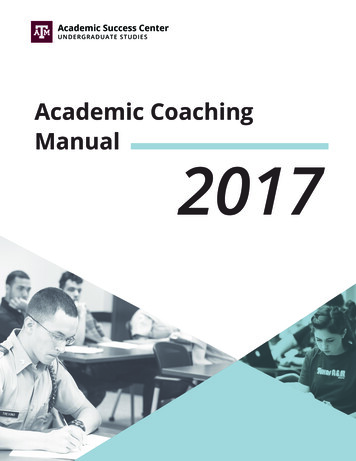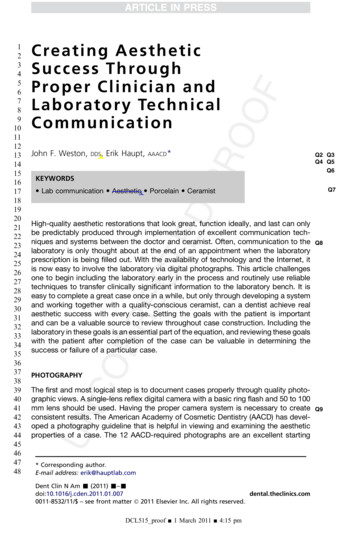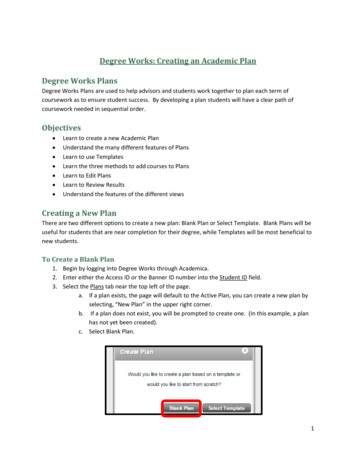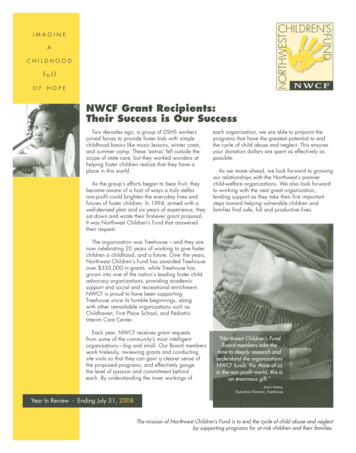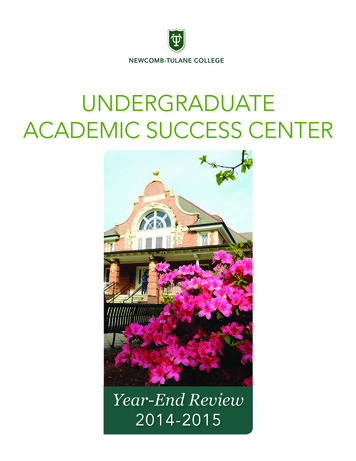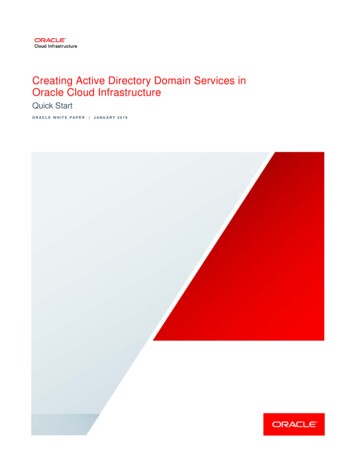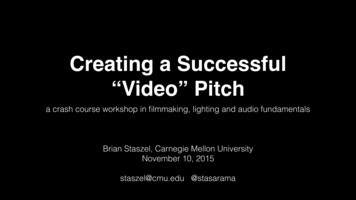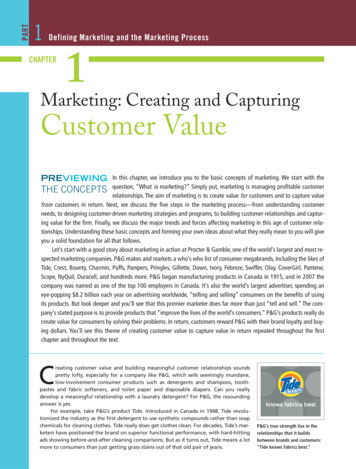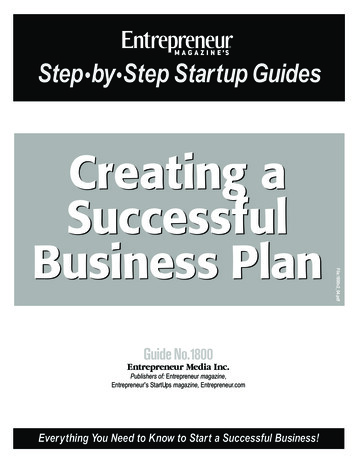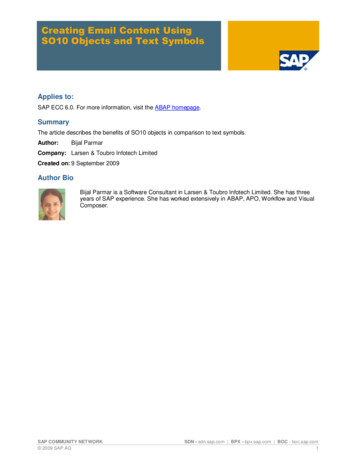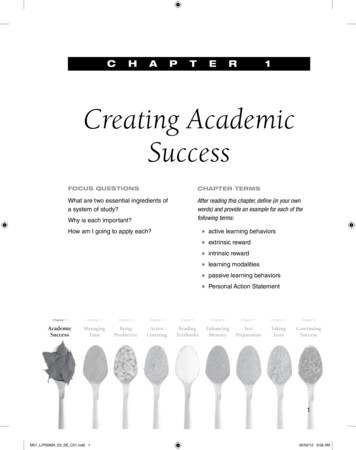
Transcription
Chapter1Creating AcademicSuccessFocus QuestionsChapter TermsWhat are two essential ingredients ofa system of study?After reading this chapter, define (in your ownwords) and provide an example for each of thefollowing terms:Why is each important?How am I going to apply each? active learning behaviors extrinsic reward intrinsic reward learning modalities passive learning behaviors Personal Action StatementChapter 1Chapter 2Chapter 3Chapter 4Chapter 5Chapter 6Chapter 7Chapter 8Chapter tionTakingTestsContinuingSuccess1M01 LIPS0894 03 SE C01.indd 102/02/12 9:58 AM
2Chapter 1A System of Study:The Essential IngredientsAs a college student, you no doubt haveexperienced—or will experience— approaches toward instruction and requirements for learning that are unlike those experienced in your previous years of education. Recenthigh school graduates often welcome the greater personaland social freedoms associated with college life. However, alongwith these freedoms come challenges. No longer does a teacher ora parent oversee your learning; at the postsecondary level, you, the student, are expected to be a self-directed and self-motivated learner.For the nontraditional student, college life offers a different set of challenges: Returning to school after a hiatus often creates a complicated jugglingact among job, family, and academic responsibilities. Whatever the personalcircumstances, individual students require their own sets of learning strategiesto meet the multifaceted challenges encountered at the college level effectively.This text provides you, the student, with the tools for developing the strategies you need to become a self-directed learner and achieve academic successthroughout your college career.By the time you enter college, you have developed a system of study basedon two essential ingredients: your learning behaviors and your learning attitudes.Each is discussed in the following sections.Your Learning BehaviorsThe term learning behaviors refers to a variety of actions carried out inan academic situation. These learning behaviors combine to form yoursystem of study. Note that some behaviors are conducive to learning,such as arriving at class several minutes early with notepaper and pen, sitting inthe front or middle of a classroom, listening attentively and selectively, askingquestions to clarify points, reviewing notes after class, seeking out help whenneeded, and so on. These are termed active learning behaviors because theyrepresent self-responsibility, initiative, and involvement in the learning process.Active learning behaviors lead to successful outcomes—that is, high grades anda smooth path toward graduation.In contrast, a host of behaviors impede learning, such as skipping classes,sleeping during classes, yielding to distractions, studying after social and leisureactivities, and not seeking assistance when needed. These are termed passivelearning behaviors. Students exhibiting these behaviors do not take charge oftheir learning. Passive learners often are not accustomed to working hard inschool; they tend to devote minimal time and effort to their academic life.M01 LIPS0894 03 SE C01.indd 202/02/12 9:58 AM
Creating Academic Success3This text will introduce you to active learning behaviors at the college level.Each chapter focuses on a group of active learning behaviors—or strategies—related to a major study skills topic. Principal elements of each topic are labeled“Essential Ingredients.” Within each chapter you will be given choices of whichstrategies you will put into practice as you engage in your day-to-day collegecourse work.Your Learning AttitudesYour attitude toward all aspects of academic life (going to class, interacting with the instructors, completing assignments, studying) has a hugeimpact on your accomplishments in college. Successful college studentsexhibit the following characteristics: Motivation. They want to achieve and are determined to reach their academic goals.Persistence. They do not let hurdles block personal achievement. Whenproblems arise, they seek out help and persevere until a satisfactory solutionis reached.Self-Discipline. They are willing to make the necessary sacrifices and devotethe necessary efforts to receive that college degree. Even more than measuresof intelligence, students’ levels of self-discipline are associated with academicsuccess.A Personal Support Network. They have at least one family memberor close friend they can rely on for personal encouragement and support.Likewise, they tend to associate with peers who are responsible and caring.How many of these characteristics do you exhibit at this point in your collegecareer? As you read the upcoming chapters in this text, you will be exploring youroutlook toward the many aspects of college life and determining if your attitudeswork for or against your immediate and long-term successes.Online Course WorkBecause distance education can be a very anonymous and independent process, your levels of motivation, persistence, and self-disciplineare especially important. Oftentimes students enroll in online courses forreasons that work against their success. For example, they are disinterestedin the subject, want to get the course out of the way, or think distanceeducation courses are easier than face-to-face instruction. You are muchmore likely to do well in online course work if you assume the mind-set of“What can I learn?” as opposed to “How little can I do to pass?”M01 LIPS0894 03 SE C01.indd 302/02/12 9:58 AM
4Chapter 1Keep in mind that in college, you will be determining your own academicpath; thus it is up to you to take responsibility for your successes—or failures.This mission of self-determination and responsibility can be accomplished by anawareness of why you are here, what you want to accomplish, and how you candevelop a viewpoint that contributes to personal success.CriticalThinkingTaskpause. and reflect What motivates you to achieve?Are you persistent when faced with a problem or stumbling block? Providea personal example.Research indicates that self-discipline is more important than IQ in predicting academic success. Why do you think this is? Would you describeyourself as self-disciplined in regard to school? In what areas are youself-disciplined? Describe in what areas you are not self-disciplined, andexplain why.Who is part of your personal support network?Learning ModalitiesLearning modalities refer to the senses involved in various approaches orstrategies for learning and studying. Some strategies favor visual (seeing)modes of learning, while other strategies favor auditory (hearing) or tactile/kinesthetic (feeling/moving) modes, as described below: Visual strategies help students see information in their mind. Visualmethods emphasize organization and spatial images, such as illustrations,charts, maps, and other graphic formats, and often include the use of colorand design.Auditory strategies help students hear information in their mind and ofteninvolve listening, verbalizing, and discussing new knowledge. Examples ofauditory learning methods are listening to audio files and talking aloud toyourself and others.Tactile/kinesthetic strategies help students learn through the physicalsensations of touching and moving. Examples of tactile/kinesthetic learningmethods are the use of real-life models and simulations, videos, role-playing,laboratory work, and field trips.M01 LIPS0894 03 SE C01.indd 402/02/12 9:58 AM
Creating Academic Success5As a college student, be mindful that:1. You likely use all three modalities at various times and in varying situations.2. Generally it is to your advantage to utilize strategies employing multiplemodalities, especially when you want to understand and remember contentthat is new and complex.3. You will benefit from application and practice strategies, such as use of casestudies, examples, demonstrations, and simulations. These types of strategiesare most often associated with tactile/kinesthetic modalities.At the ends of text chapters, you will identify, implement, and evaluate specific visual, auditory, and tactile/kinesthetic learning and study strategies, withthe goal of creating a system of study that is successful for you.CriticalThinkingTaskpause. and reflectWhat modalities do you use in a learning situation? For each of the following situations, describe your favored learning strategies. Identify each strategy as usingprimarily visual, auditory, or tactile/kinesthetic modalities, or a combination ofmodalities. Reading a chapter for a history course.Writing the first draft of a research paper.Completing math-based homework problems.Studying for a test in a science course.As you transfer suggested learning strategies to your daily course work, youwill continually assess the success or failure of the strategies. The following section describes a process to assist you with applying and assessing strategies as youbuild and strengthen an effective system of study throughout your college career.A Path to Success: Personal Action StatementsAsuccessful system of study requires much trial and error; you must trya strategy to know whether it will work for you. Your academic path in college will be strewn with both successes and failures. Savvy students arealert to which strategies do and do not work for them and, when needed, they takethe initiative to substitute other techniques. A Personal Action Statement is oneway to oversee the piece-by-piece construction of your overall system of study. It isa concise, step-by-step, written plan of one specific strategy—either a behavior or anattitude—that you commit yourself to doing within a predetermined span of time.M01 LIPS0894 03 SE C01.indd 502/02/12 9:58 AM
6Chapter 1Effective Personal Action Statements entail reflection, decision making,and judgment on your part. Because you are required to deliberate, analyze, andcritique, each Personal Action Statement is designated as a critical thinking taskwithin the chapters.Use these guidelines to ensure a successful Personal Action Statement:CriticalThinkingTask Recognize that a Personal Action Statement is a commitment to yourself foraction.Make the Personal Action Statement manageable by identifying a specific stepto implement.Be realistic and honest with yourself. Identify a step, or strategy, that youintend to do, as well as hurdles and rewards for yourself.Be willing to put both thought and time into the Personal Action Statement.Know that, for most students, the results are worth the effort. Soon, you willbecome adept at identifying and outlining strategies and steps. You will beable to see how the Personal Action Statements can motivate you toward action and achievement as you continue to build a system of study for yourself.Type your answers for each step. Writing space is limited on text pages.Furthermore, when you type you are able to make more revisions, resultingin higher quality responses.Here is the setup for the Personal Action Statement:1.2.3.4.5.I will:My greatest hurdle to achieving this is:I will eliminate this hurdle by:My time frame for achieving this is:My reward for achieving this is:.On line 1, write what you intend to do. Write a strategy that is specific, realistic, and meaningful to you. Here are some examples: “I will study in a library study room three nights next week.”“I will improve my concentration by taking short breaks every 30 minuteswhen reading my biology textbook.”Line 2 refers to what you anticipate as being the greatest barrier towardcompleting the Personal Action Statement. Relying on past experiences andyour personal weaknesses, what tends to hinder successful completion of yourschoolwork? Examples of hurdles are boredom, the temptation to play an onlinegame, friends dropping by to chat, and your dislike of the subject matter or theinstructor. Be honest with yourself: What tends to obstruct your study plans?On line 3, write how you will overcome the hurdle identified in line 2. Whatcan you do realistically to reduce, if not eliminate, this barrier? For instance,you can study with a classmate to relieve boredom, or use an online game onlyas a break from studying, or be more assertive with your friends, or talk to yourprofessor about your problems.M01 LIPS0894 03 SE C01.indd 602/02/12 9:58 AM
Creating Academic Success7On line 4, indicate your time frame. When are you going to implement thisPersonal Action Statement? Make the time frame immediate; begin as soon aspossible.On line 5, identify a reward for completing your Personal Action Statementsuccessfully. It can be an internal or intrinsic reward (such as a sense of satisfaction with a high test grade or increased confidence from knowing subject matter)or an external or extrinsic reward (such as using a social media site, watching afavorite television program, or talking to a friend).After completing the Personal Action Statement, place it in an accessible location (such as above your desk, in your planner, or on your computer or smart phone)so that you can refer to it regularly to remind yourself about your intentions.The last, yet very important, step in this process is the follow-up. At the conclusion of implementing your Personal Action Statement, assess critically what happened. Did you accomplish all that you set out to accomplish? If so, great—rewardyourself! Think about the factors that contributed to your success. Use the followup as a time to evaluate what happened and anticipate building on your successes.Also, learn from your partial successes as well as failures. If everything didnot work out as anticipated, do not berate yourself. Keep in mind that risk taking is an inherent part of change, and it is inevitable that you will not always besuccessful when taking risks. However, do learn from your ineffective PersonalAction Statements. Analyze what happened. Often students make their PersonalAction Statements either too general or too unrealistic (refer to the examplesthat follow). Think about how you can shape your Personal Action Statement tomake it more specific and/or practical.TOO GENERAL:MORE SPECIFIC:I will improve my timemanagement.I will put class assignments in myplanner.TOO UNREALISTIC:MORE REALISTIC:I will study in the library forthree hours every night this week.I will study in the library for twohours on three days this week.How about the anticipated hurdle? Did it actually emerge? If so, were you ableto overcome it effectively? Did you discover other impediments? Furthermore,was your time frame appropriate for completing the Personal Action Statement?Finally, examine your reward. Did you identify a reward that is meaningfulto you? Your reward should motivate you to finish a task and make you feel goodabout succeeding. Dangle a reward in front of yourself that you really want—and can have!Answering these and similar questions will aid you in analyzing what learning strategies do and do not work for you. It takes deliberate practice to developeffective Personal Action Statements, but the practice is worthwhile. Not onlywill you be learning about valuable college study strategies, but you also will belearning about yourself!M01 LIPS0894 03 SE C01.indd 702/02/12 9:58 AM
8Chapter 1ConclusionYour success in college depends on a combination of factors: your behaviors in and out of class, your attitude and commitment to working hard,your awareness of key learning strategies, and your commitment to applying and accessing these strategies in your daily life. The following checklistcontains keys to a successful academic year, elements that directly relate to success, satisfaction, and, ultimately, graduation from college. As the year progresses,review the checklist periodically with the goal of accomplishing as much as youcan to keep yourself on the track of academic success.Keys to a Successful Academic Year1. Be aware of why you are attending college, as well as what you expectto get out of college. Whose decision was it to attend college, yours or yourfamily’s? Are you attending the college of your choice? Do you intend tograduate from this or from another college? What do you expect to accomplish in college? Be honest with yourself and clear in your goals.2. Know what is expected of you in each subject. Read each syllabus. Make anappointment with each instructor. Attend all classes. Go to review sessions orform your own study group. Ask, and then write down the answers!3. Manage your time wisely. Establish a routine; be aware of the dangersof too much free and unstructured time. This is especially true for online course work. Muster the self-discipline to say no to tempting peopleand activities. Also, create a balance among your academic, personal, andsocial/leisure lives. Assess your priorities periodically: Do you typicallyplace your academic responsibilities before your social aspirations? Do youallow yourself time for fun between the academic and personal demandson your time?4. Develop and use effective methods of study. Create a study system thatis advantageous to you; choose, use, and evaluate recommended learningstrategies. Form beneficial habits early in the year.5. Involve yourself in college life. Students who participate in academic, social,and personal campus activities tend to do better academically. Create linksbetween yourself and other people within the college community. Make commitments like these: Join a student organization or club related to your interests or major. Obtain a campus job. Participate in academic support services, such as tutoring, group studysessions, and workshops, or become a tutor or peer educator. Go to campus cultural events, such as guest speakers, fine arts productions, and museum exhibits. Participate in intramural sports and other extracurricular activities.M01 LIPS0894 03 SE C01.indd 802/02/12 9:58 AM
Creating Academic Success96. Avoid these hazards: Mishandling of your personal freedom and time Misuse of alcohol and drugs Mishandling of your personal health Mishandling of your best interestsCriticalThinkingTaskpause. and reflectRefer to the checklist that offers keys to a successful academic year. At this point in yourcollege career, where would you place yourself?For each of the six items, write a short paragraph assessing yourself at this time.Include what you have done, as well as what you still need to accomplish.try it out!Create a sample Personal Action Statement by choosing one of the items thatyou still need to accomplish for a successful academic year. Use the followingexamples as models.CriticalThinkingTaskExamples of Personal Action Statements1. I will: become more involved in campus life by obtaining an on-campus job.2. My greatest hurdle to achieving this is: not knowing where campus jobs areadvertised.3. I will eliminate this hurdle by: (1) asking my adviser about job listings during ourmeeting on Wednesday, and (2) investigating the Career Services office Web site.4. My time frame for completing this is: by Thursday of this week.5. My reward for achieving this is: the self-satisfaction of knowing that I beganlooking for a job early in the semester!1. I will: set aside definite times during the afternoon to do both math and chemistryproblems.2. My greatest hurdle to achieving this is: the distractions of TV and people in myapartment.3. I will eliminate this hurdle by: studying at a desk at the library during the afternoons when I have large chunks of free time.4. My time frame for completing this is: next Tuesday.5. My reward for achieving this is: not having unfinished work hanging over my head.M01 LIPS0894 03 SE C01.indd 902/02/12 9:58 AM
10Chapter 11. I will: join a campus club related to my interest in an outdoor sport.2. My greatest hurdle to achieving this is: not knowing what clubs are here.3. I will eliminate this hurdle by: checking the Web site for the Office of StudentOrganizations and narrowing my options to two or three clubs that I will contactand visit.4. My time frame for completing this is: within the next 2 weeks.5. My reward for achieving this is: the knowledge that I actually followed throughwith something, as well as looking forward to meeting other students.Your Personal Action Statement1. I will:2. My greatest hurdle to achieving this is:3. I will eliminate this hurdle by:4. My time frame for achieving this is:5. My reward for achieving this is:Comprehension CheckRM01 LIPS0894 03 SE C01.indd 10eturn to page 1. Without looking back through the chapter, provide acomplete answer for each focus question. Then, define each chapterterm in your own words and provide an example.02/02/12 9:58 AM
action. Make the Personal Action Statement manageable by identifying a specific step to implement. Be realistic and honest with yourself. Identify a step, or strategy, that you intend to do, as well as hurdles and rewards for yourself. Be willing to put both thought and
